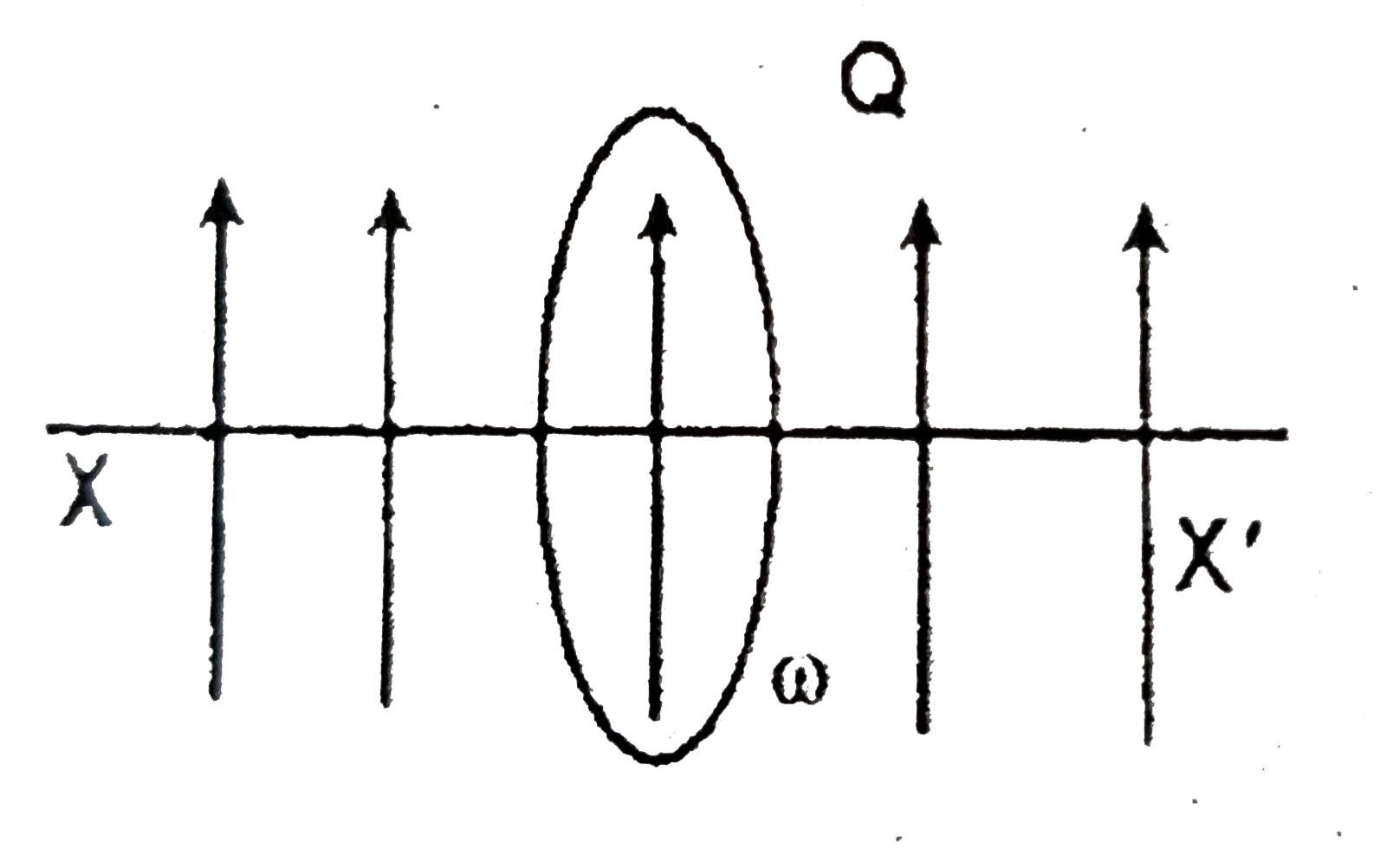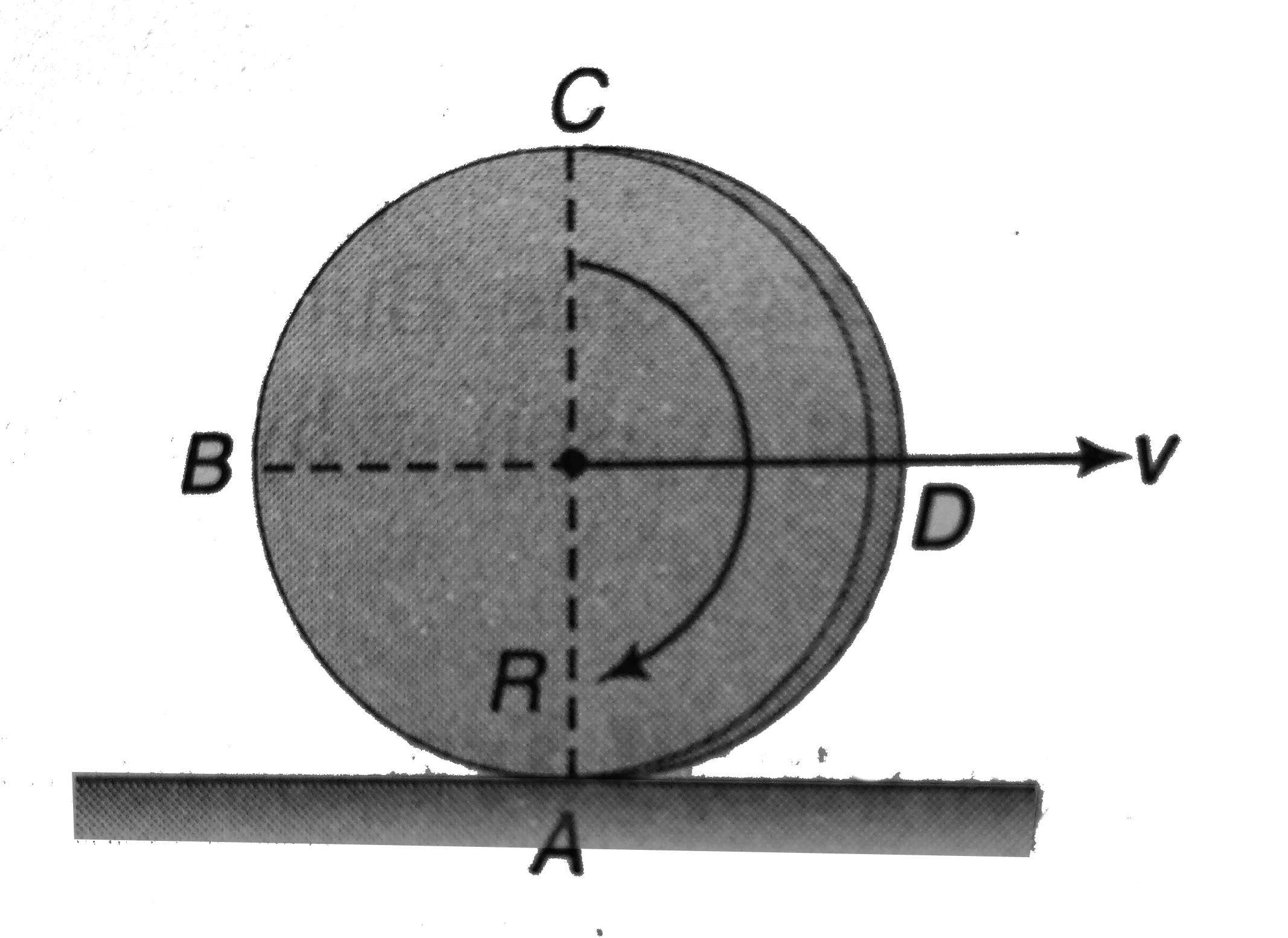Two discs A and B are mounted coaxiallay on a vertical axle. The discs have moments of inertia I and 2 I respectively about the common axis. Disc A is imparted an initial angular velocity 2ω using the entire potential energy of a spring compressed by a distance x1 Disc B is imparted an angular velocity ω by a spring having the same spring constant and compressed by a distance x2 Both the discs rotate in the clockwise direction.
When disc B is brought in contact with disc A, they acquire a common angular velocity in time t. The average frictional torque on one disc by the other during this period is
2Iω3t
9Iω2t
9Iω4t
3Iω2t
The correct Answer is:A
To solve the problem, we will follow these steps:
Step 1: Identify the Moments of Inertia and Initial Angular Velocities
- Disc A has a moment of inertia IA=I and an initial angular velocity ωA=2ω.
- Disc B has a moment of inertia IB=2I and an initial angular velocity ωB=ω.
Step 2: Apply Conservation of Angular Momentum
When the discs come into contact, they will rotate together with a common angular velocity ω′. According to the conservation of angular momentum:
IAωA+IBωB=(IA+IB)ω′
Substituting the values:
I(2ω)+(2I)(ω)=(I+2I)ω′
This simplifies to:
2Iω+2Iω=3Iω′
Thus, we have:
4Iω=3Iω′
Step 3: Solve for the Common Angular Velocity ω′
Dividing both sides by 3I:
ω′=43ω
Step 4: Calculate the Change in Angular Momentum for Disc B
The change in angular momentum for disc B can be calculated as follows:
- Initial angular momentum of disc B:
LBinitial=IBωB=2I⋅ω
- Final angular momentum of disc B:
LBfinal=IBω′=2I⋅43ω=83Iω
- Change in angular momentum:
ΔLB=LBfinal−LBinitial=83Iω−2Iω
This simplifies to:
ΔLB=83Iω−63Iω=23Iω
Step 5: Relate Change in Angular Momentum to Average Frictional Torque
The average frictional torque τ exerted by disc A on disc B over time t is given by:
τ⋅t=ΔLB
Thus:
τ=ΔLBt=23Iωt=2Iω3t
Final Answer
The average frictional torque on one disc by the other during this period is:
τ=2Iω3t
- Disc A has a moment of inertia IA=I and an initial angular velocity ωA=2ω.
- Disc B has a moment of inertia IB=2I and an initial angular velocity ωB=ω.
When the discs come into contact, they will rotate together with a common angular velocity ω′. According to the conservation of angular momentum:
IAωA+IBωB=(IA+IB)ω′
Substituting the values:
I(2ω)+(2I)(ω)=(I+2I)ω′
This simplifies to:
2Iω+2Iω=3Iω′
Thus, we have:
4Iω=3Iω′
Dividing both sides by 3I:
ω′=43ω
The change in angular momentum for disc B can be calculated as follows:
- Initial angular momentum of disc B:
LBinitial=IBωB=2I⋅ω
- Final angular momentum of disc B:
LBfinal=IBω′=2I⋅43ω=83Iω
- Change in angular momentum:
ΔLB=LBfinal−LBinitial=83Iω−2Iω
This simplifies to:
ΔLB=83Iω−63Iω=23Iω
The average frictional torque τ exerted by disc A on disc B over time t is given by:
τ⋅t=ΔLB
Thus:
τ=ΔLBt=23Iωt=2Iω3t
The average frictional torque on one disc by the other during this period is:
τ=2Iω3t
Topper's Solved these Questions
- RIGID BODY DYNAMICS 2Book:CENGAGE PHYSICS ENGLISHChapter:RIGID BODY DYNAMICS 2Exercise:Interger
Explore 2 Videos
- RIGID BODY DYNAMICS 2Book:CENGAGE PHYSICS ENGLISHChapter:RIGID BODY DYNAMICS 2Exercise:AR_TYPE
Explore 2 Videos
- RIGID BODY DYNAMICS 1Book:CENGAGE PHYSICS ENGLISHChapter:RIGID BODY DYNAMICS 1Exercise:Integer
Explore 11 Videos
- SOUND WAVES AND DOPPLER EFFECTBook:CENGAGE PHYSICS ENGLISHChapter:SOUND WAVES AND DOPPLER EFFECTExercise:Integer
Explore 16 Videos
Similar Questions
Two discs A and B are mounted co-axially one vertical axle. The discs have moments of inertia l and 2l respectively about the common axis. Disc A is imparted an initial angular velocity 2ω using the centre potential energy of a spring compressed by a distance x1. Disc B is imparted angular velocity ω by a spring having the same spring constant and compressed by a distance x2. Both the disc rotate in the clockwise direction.
The rotation x1/x2 is.
View SolutionTwo discs A and B are mounted coaxially ona vertical axle. The discs have moments of inertia l and 2l respectively about the common axis. Disc A is imparted an initial angular velocity 2ω using the centre potential energy of a spring compressed by a distance x1. Disc B is imparted angular velocity ω by a spring having the same spring constant and compressed by a distance x2. Both the disc rotate in the clockwise direction.
The loss of kinetic energy the above process is -
View SolutionTwo bodies have their moments of inertia I and 2I, respectively about their axis of rotation. If their kinetic energies of rotation are equal, their angular velocity will be in the ratio
View SolutionA disc is rotating with angular velocity ω. If a child sits on it, what is conserved?
View SolutionIf I, α and τ are the moment of inertia, angular acceleration and torque respectively of a body rotating about an axis with angular velocity ω then,
View SolutionA horizontal disc rotates freely with angular velocity ω about a vertical axes through its centre. A ring having the same mass and radius as the disc, is now gently placed coaxially on the disc. After some time, the two rotate with a common angular velocity. then.
View SolutionA circular disc is rotating about its own axis at an angular velocity ω. If P is exact midpoint of dise between axis and rim of disc then angular velocity of Pis
View SolutionA disc of mass m has a charge Q distributed on its surface. It is rotating about an XX' with a angular velocity ω. The force acting on the disc is

View Solution
A disc of radius R has linear velocity v and angular velocity ω as shown in the figure. Given υ=rω find velocity of point A, B, C and D on the disc.
View SolutionA non-conducting disc having unifrom positive charge Q, is rotating about its axis with unifrom angular velocity ω.The magnetic field at the centre of the disc is.

View Solution
